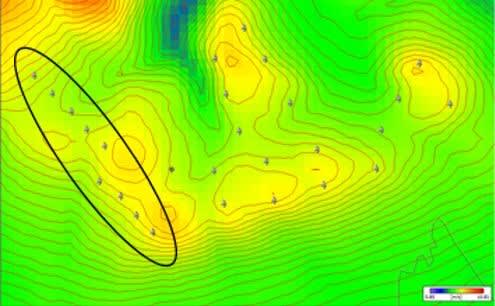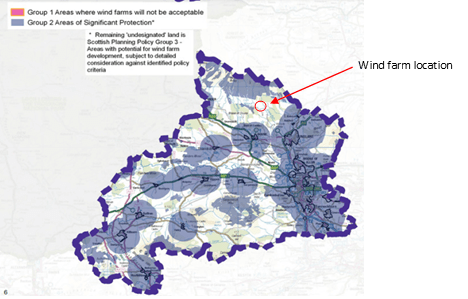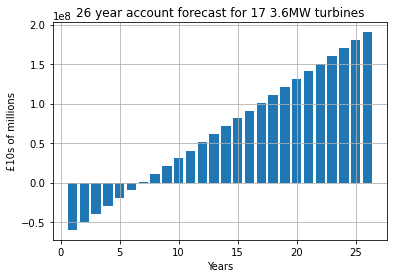Have you heard of Renewable Energy? We are Big Fans! The Wind Farm Project 2021
Follow articleHow do you feel about this article? Help us to provide better content for you.
Thank you! Your feedback has been received.
There was a problem submitting your feedback, please try again later.
What do you think of this article?
Location, Location, Location
The chosen location for this wind farm is in Stirling, Scotland. After weighing up the pros and cons for each of the six different location choices, it was decided that location 3 was the best possible location in order to bring the best possible outcomes for this wind farm. There were a few downsides to the location as it is located on complex and hilly terrain with little access to roads. However, this was seen as a positive as the local communities would benefit from the construction of a new road in the area in order to better connect them to one another. The limit for power outage limits the farm to a number of turbines that can be implemented, this gave us an aim for the wind farm; make the best possible wind farm with the cheapest possible cost per power output. There were also many positives to the site such as the possibility to use the land for farming/ cattle grazing which would benefit both the local farmers and Big Fans as the site will have a dual purpose. There are a few important sites nearby including Loch Lomond National Park, Braco Castle and a few small villages. Therefore, it was taken into great consideration where these turbines would be placed in order to minimize their impacts on the surroundings.
Designing a wind farm? …..its a breeze!
Due to cost, only two turbines were taken into consideration; turbine 1 has a rotor diameter of 100m and 2.5 MW power rating and would require 22 turbines and turbine 2 has a rotor diameter of 120m and 3.6 MW power rating and would require 17 turbines. After comparing the two options using simulation software, it was noticed that the two had similar profits and power output. Therefore, the chosen turbine was turbine 2 (120m rotor diameter, 3.6 MW power rating) as fewer need to be constructed. This would decrease the environmental impact of the individual turbines on the habitats and soil in the area as less foundations need to be dug. Similarly, it tends to be easier to maintain a smaller number of turbines and said maintenance will have a lower impact on the wind farm’s annual power output.
The existing wind farm is highlighted by the black circle, after undertaking extensive research, it was found that the implementation of Big Fans’ wind farm will incur zero wake losses to the existing farm. This will help to build positive relationships and encourage our green neighbours.
Worried about the social impacts? No need! They’re all gone with the wind.
The same as any other huge construction project, there are several impacts that a wind farm will have on the local community. Great consideration has been taken when evaluating the social impacts on the local community in order to minimize and mitigate any negative impacts and encourage and promote the positive impacts.
Several common impacts have been considered in order to begin the process of minimizing these negative impacts. Also, the wind turbines have been placed at specific locations in order to have minimal effects on the community, therefore, the community should not at all be affected by noise, vibration and shadow flicker but we would be happy to consider implementing a response if it would make the community happier about the process.
|
Social Impacts |
Response |
|
Noise |
Serrated trailing edge blades in order to reduce aerodynamic noises. |
|
Vibrations |
We would be willing to include active damping to the wind turbines in order to mitigate this concern. |
|
Shadow flicker |
We would be willing to introduce shadow flicker technology if required. |
|
Eyesore |
We understand that residents are not usually excited by the view of wind turbines, therefore, we have placed these far from any residences or buildings so these should not be viewable from their homes. However, we have chosen to place the wind turbines to the south of the hills which should obscure some of the views. We want the community of Stirling to be proud of its contribution to a cleaner, greener future. Displaying these turbines should state to the rest of Scotland that Stirling is renewable and proud. |
|
The Resident’s health will increase over time. |
People would not be exposed to as many hazardous wastes and emissions because people would be moving away from burning fossil fuels and using cleaner, greener energy such as wind power. |
|
They provide both short-term and long-term employment during different phases of development. |
On average there are 0.5 jobs per megawatt of wind power capacity provided. Due to an approximated 215.47GWh (24.9MW) per annum being generated by the wind farm, a total of 13 employment opportunities will be created for the local community. |
|
Building roads |
Building access roads will only be temporary and the introduction of a new road in this area will improve transportation for the local community and link the community to other communities nearby. |
|
Risk to life |
During construction, there is an obvious risk to the construction workers. The principal designer should undertake site investigations and create a health and safety file along with a risk assessment in order to mitigate any risks to construction workers. |
An extensive public engagement plan has been formed in order to clearly lay out how the community will be involved throughout the planning process in order to bring the best possible outcome for everyone involved and to give the community the opportunity to voice any concerns and truly understand the nature of the project.
One good turn deserves another – how we will help the environment, whilst also providing green energy.
The Stirling Council has published Supplementary guidance for Wind Energy Developments. Within the document, they display several maps and figures in order to state where is and where isn’t appropriate for wind farms to be placed. This provides us with confirmation that the site location for the wind farm is within the ‘areas with potential for wind farm development’ and therefore it can be assumed that this area is allowable for the project and that the soil and ground conditions are suitable. As the wind farm will have a power output of over 20MW, this will be a major application and would be up to the local council to approve the project. As the plans follow the recommendation of the Stirling Council, this gives us the best possible chance for approval.
|
Environmental Impacts |
Mitigation Measures |
|
Impacts of Fauna |
A majority of impacts on fauna is due to turbine noise/ vibration and construction work. The noise/ vibration mitigation techniques have been highlighted under social impacts but also hope to minimalize effects by construction work. By choosing a smaller number of turbines, fewer foundations and therefore fauna need to be displaced. We will work carefully with the local animal conservation group to move these habitats safely. |
|
Impacts on Flora |
Disturbance of local ecosystems can be caused by the construction and operation of wind farms. Since the chosen site is mainly peatland, there is no known threatened flora on the site. |
|
Impacts on Birds |
It has been found that painting one blade black decreases bird collision and subsequent deaths by 70%, we are very excited by this new study and plan on implementing this into our turbines. Similarly, if another blade is painted with UV paint, this will deter bats during the night. |
|
Impacts on Trees |
The chosen site does not display any trees in the area, this is an advantage as the company does not need to worry about cutting down trees and affecting the wildlife. |
|
National Parks nearby |
Loch Lomond and the Trossachs National Park is at least 7km, therefore, the distance is sufficient so visitors of the park will not be affected by noise, vibrations or shadow flicker. The main issue would likely be the view of the turbines from the park. Due to distance and the presence of trees and forestry area, the turbines should not be too noticeable, however, we understand that this issue cannot be completely removed, this is a necessary risk when building a wind farm and working towards cleaner energy. |
|
Soil |
The area is mostly grade 1 soil suggesting that it is mostly peatland. Disturbing peat soil to construct wind farms can be a significant source of carbon emissions. Construction work may create a risk of disruption to peatland hydrology which could cause localized areas of peat within the area of a wind farm to dry out, disintegrate, and so release their stored carbon. However, after weighing up how much carbon emissions are saved during the turbine life cycle compared to the carbon emissions released when working on peat soil, this is a necessary impact. |
|
Air pollution |
Wind energy is clean and does not contribute to air pollution. |
|
Land use |
Land can be used by farmers to graze their animals such as sheep as sheep are low maintenance and can happily live at the base of a wind turbine. These large turbines can also provide shelter and shade from strong winds and weather. |
|
Construction |
The construction of a road leading up to the site will release carbon emissions due to the materials required and the physical construction of the road. Similarly, the construction of the wind turbines will release carbon emissions during construction due to the material required. However, we have decided that this is necessary as the benefits of the wind farm and new road will outweigh the disadvantages of the carbon emissions released during construction as the wind turbines will benefit the national grid by providing clean energy and the road is necessary to access the wind farm, and it should also benefit the community by connecting them to nearby communities. |
|
Materials |
Wind turbines are made up of a mixture of steel, fibreglass, plastic, iron, copper and aluminium. The materials that make up wind turbines are finite materials, however, after their average 25-year lifetime, these materials can be recycled or sent to the landfill. If these materials were to be sent to a landfill, obviously this situation is less than ideal but the positive outcome of providing clean energy for 25 years outweighs the negative impacts of landfill. Similarly, the wind turbine blades can be re-used by repurposing them into containers, footbridges, eco-housing, wall panels etc |
|
Weather and Climate Change |
Wind farms may affect weather in their immediate vicinity. Turbulence from spinning wind turbine rotors increases vertical mixing of heat and water vapour that affects the meteorological conditions downwind, including rainfall. Overall, wind farms lead to slight warming at night and a slight cooling during the daytime. Warming at night could "benefit agriculture by decreasing frost damage and extending the growing season. We see this as a benefit. |
The team have worked hard to ensure that these plans for a wind farm in Stirling, Scotland are environmentally sound. The effects that this wind farm could possibly have on the environmental have been minimalized and diminished to the best of our abilities.
We are aware that there are a few negative environmental impacts, however, these have been reduced as much as possible and it has been decided that the positive outcomes of building a clean energy wind farm far outweigh the negative impacts the farm might initially have on the environment.
These financial figures will blow you away!
Without boring you with lots of numbers and calculations, here’s a quick overview of Big Fan’s financial plan.
Construction Costs: total = £59,842,500
Overall income per year = £70 x 215,473 = £15,083,164
Income over 25 years of operation (26 years from project start state) = 25 x £15,083,164 =
Total = £377,079,097
Yearly Losses: total = £126,903,705
Net Revenue. After a year of construction and 25 years of operation, our final bank balance after 26 years will be:
Net profit = Total annual income – total annual losses – construction
= £377,079,097 - £126,903,705 - £59,842,500
= £190,332,892
This graph gives a visual overview of costs and profits over the 25 years life cycle of the wind turbines and 1-year construction. This shows that it will take 7 years until profits are seen, however, once profits start, they keep going up! This leads to an overall profit of just under £200 million!
This profit should just keep going up with Big Fans’ plan for re-using and re-selling turbine parts as part of our decommissioning plan.
I came, I spun, I…. what comes next???
There are many considerations that need to be undertaken for the construction, operation and decommissioning of the wind turbines. During the construction process, an extensive risk assessment should be undertaken and first aid training must be undertaken by everyone on-site as the closest hospital is over 15 miles away and it is difficult to access the site until the road is constructed. Since the area is hilly terrain and the wind turbines will be located on the south side of the hill, flooding should not be an issue, however, flood risk management should be undertaken in order to assess the possible risk and allow us to introduce mitigation techniques so the turbines will not be affected by heavy rainfall. There is always a risk of grid curtailment when operating a wind farm, this could happen when the grid is full of power and therefore the wind turbines must be switched off in order to prevent the grid from overflowing. This would prevent the company from profiting, careful detail should be taken into account in order to prevent this such as other wind company's prices in order to make this wind farm the most desirable.
Annual maintenance must be undertaken for each turbine. In order to decrease the loss of profit incurred by this, maintenance should be done on days when the wind speed is slow.
With regards to decommissioning, the company can see the turbine parts for profit. The options for decommissioning include recycling, re-using or landfill. As the wind turbine is made of 70% steel, this material can be easily recycled. For the other composite materials which are more difficult to recycle, these can be re-used. There are many examples of turbine blades being re-purposed as containers, wall panels and even eco-housing. Once the life span of these turbines is complete it would be of the utmost importance to avoid sending the turbines to landfill and instead re-use and recycle to the best of our ability as the materials required for a turbine are finite and it is important to preserve them.
Relevant Articles
ClimateXChange 2021. [online] Available at: <https://www.climatexchange.org.uk/media/1856/wind_farms_-_review_of_good_practice _on_community_engagement_-_final_report_14_06_16.pdf> [Accessed 26 May 2021].
Planning.vic.gov.au. 2021. [online] Available at: <https://www.planning.vic.gov.au/__data/assets/pdf_file/0038/68897/Appendix-19-Stakeholder-Engagement-Plan.pdf> [Accessed 26 May 2021].
Stirling.gov.uk. 2021. [online] Available at: <https://stirling.gov.uk/media/6079/wind-energy-sg-february-2019.pdf> [Accessed 27 May 2021].



